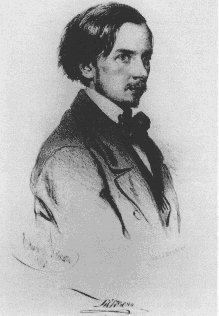Kertbeny: "Homosexual," "Heterosexual," May 6, 1868
Inventing the Homosexual and Heterosexual Categories
by Jonathan Ned Katz
Copyright (c) by Jonathan Ned Katz, 2008. All rights reserved.
In a letter, in German, to Karl Heinrich Ulrichs on May 6, 1868, an early sex-law reformer, the writer Karl Maria Kertbeny, is first known to have privately used four new terms he had coined: "Monosexual; Homosexual; Heterosexual; und Heterogenit" -- the debut of the homosexual and heterosexual categories, and two now forgotten terms.[1]
Though Kertbeny's letter did not define his foursome, his other writings indicate that "Monosexual" referred to masturbation, practiced by both sexes. "Heterogenit" referred to erotic acts of human beings with animals. "Homosexual" referred to erotic acts performed by men with men and women with women. And "Heterosexual" referred to erotic acts of men and women with each other, as did another of his new terms, "Normalsexualitat," normal sexuality.
Heterosexuality and normal sexuality he defined as the innate form of sexual satisfaction of the majority of the population. That emphasis on numbers as the foundation of the normal marked a quantitative break with an older, qualitative, procreative standard of sexual propriety.
But Kertbeny's heterosexual and his normal sexual were, by no means, normative. Both the heterosexual and normal sexual were characterized by their "unfettered capacity for degeneracy."[2]
The sex "drive" of normal sexuals was said to be stronger than that of masturbators, bestialists, or homosexuals, and this explained normal sexuals' laxity, license, and "unfetteredness."
Kertbeny's heterosexual men and women participated with each other
in so-called natural [procreative] as well as unnatural [nonprocreative] coitus. They were also capable of giving themselves over to same-sex excesses. Additionally, normally-sexed individuals were no less likely to engage in self-defilement [masturbation] if there was insufficient opportunity to satisfy their sex drive. And they were equally likely to assault male but especially female minors . . . ; to indulge in incest; to engage in bestiality . . . ; and even to behave depravedly with corpses if their moral self-control does not control their lust. And it is only amongst the normally-sexed that the special breed of so-called "bleeders" occurs, those who, thirsting for blood, can only satisfy their passion by wounding and torturing.
Considering psychiatrists' later cooptation of the term heterosexual to affirm the superiority of different-sex eroticism, Kertbeny's coinage of heterosexual in the service of homosexual emancipation is one of sex history's grand ironies.
Kertbeny's four terminology coinages raise the question: why did some of his terms gain widespread, international acceptance, and why were some forgotten?
Kertbeny's heterosexual and homosexual terms categorized people and their acts based on the erotic character of those acts, and the biological sex of the person with whom they were interacting. This was a major historical paradigm shift away from the earlier procreative/non-procreative standard.[3]
See also: Heterosexual History Timeline
References
- ↑ Adapted from Jonathan Ned Katz, The Invention of Heterosexuality (NY: Dutton, March 1994), p. 52-53. The original German text of Kertbeny's letter to Ulrichs of May 6, 1868, is printed in facsimile and in typed transcription with a brief introduction in German and a bibliography by Manfred Herzer in the periodical Capri: Zeitschrift fur schwule Geschichte 1 (1987), 25-35. Katz is grateful to Herzer for sending him a copy and to Michael Lombardi-Nash for translating this letter and for sending copies of his translation of works by Karl Heinrich Ulrichs, and to Paul Nash for sponsoring those copies. Kertbeny and his work are discussed in Manfred Herzer, "Kertbeny and the Nameless Love," Journal of Homosexuality 12:1 (Fall 1985): 1-25, and Jean-Claude Féray and Manfred Herzer, "Homosexual Studies and Politics in the Nineteenth Century: Karl Maria Kertbeny," trans. by Glen W. Peppel, Journal of Homosexuality 19:1 (1990), 23-47. The meaning of Kertbeny's terms is also discussed in Manfred Herzer to Katz, April 16, 1989, now in the Manuscripts and Archives Division, New York Public Library. Katz stresses his gratitude for the letters and wonderful research of Manfred Herzer. Katz is also indebted to the pioneering work of John Lauritsen and David Thorstad on the history of the homosexual emancipation movement in nineteenth-century Germany -- see their pamphlet The Early Homosexual Rights Movement (1864-1935) (NY: Times Change Press, 1974 -- and to James D. Steakley's The Homosexual Emancipation Movement in Germany (NY: Arno Press, 1975).
- ↑ Féray and Herzer, pp. 34-35.
- ↑ Discussed by Katz in The Invention of Heterosexuality.
<comments />
